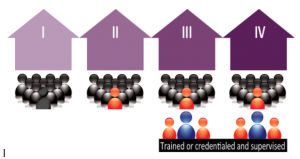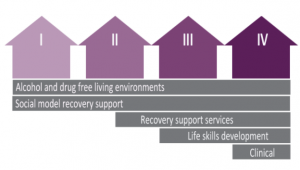Level Delineation
Please sign in or create your account in order to access this material.
While some of NARR’s standards apply to all Levels, some standards only apply to some Levels, which means the most accurate way to determine a recovery residence’s Level is through certification. That being said, recovery residences can often be quickly sorted by their staffing and governance structure and service bundle.
Staffing and Governance Model
Different Levels of Support use different staffing and/or governance models.
- Democratic Leadership – Level Is is self-governing and democratically run, meaning the residents of each home elect resident leaders (such as the House President and House Treasure) and vote on decisions. Level Is can receive external guidance to maintain fidelity and stability. Oxford House is the most well-known example of a Level I. Note: All recovery residences cultivate a social model through peer leadership and governance, Level IIs, IIIs, and IVs are led by staff or an owner/operator, but they empower residents and/or alumni through planning or advisory committees. Sometimes the household votes during house meetings on whether or not a referral is a good match or if a former resident who left can reapply. Whether the community is entirely democratically run or empowered within a narrower scope, these are effective means of cultivating social model recovery.

- Peer Staffed – Owner/operators of Level II, III, and IVs, appoint a senior resident to be the Residence Manager (House Manager). The Manager’s responsibilities can vary greatly depending on the organization’s size and the division of labor. Compensation ranges from reduced or no rent to part-time or full-time salaries.
- Supervised Staff – Level IIIs and IVs serve residents with less recovery capital and/or higher or more complex needs. As such, Level III and IV staff require more significant workforce development and performance support, known as supervision. Supervisors promote resiliency, skill development, role fidelity, quality assurance, and outcome improvements. Level IIIs and IVs have staffing plans that reflect the training and credentials required to deliver the bundle of services.
- Licensed Provider – Since Level IVs provide clinical services, they must have the licensed/certified and supervised professionals required by law.
Service Bundles
Different recovery residence levels offer other bundles of services to match the needs of their priority populations. These services include:
- Sober living environments – All recovery residences offer persons seeking recovery from substance use issues a safe and secure place to live alcohol- and illicit drug-free. Stable housing provides the foundation upon which people build productive lives, improve health and reach their full potential.
- Social Model Recovery – All recovery residences are found in social model philosophy, which focuses on the socio-cultural aspects of recovery.

- Person-Centered Recovery Support – Higher levels of support (Level IIIs and IVs) also provide person-centered recovery support, which, as the name implies, focuses on an individual’s unique needs. These are non-clinical services delivered in a one-on-one or group setting and by persons with lived experience trained and supervised as a Peer Specialist or similar role. Examples include Motivational Interviewing, Wellness Recovery Action Planning, Whole Health Action Management, Partners for Change Outcome Management System, Back to Basics, Making Alcoholics Anonymous Easier), and Recovery Check-ins.
- Life Skills Development Classes – Higher levels of support (Level IIIs and IVs) also provided life skills development, such as job readiness, budgeting, nutrition, relationships, and time management classes. The program should reflect the needs of the priority population, have measurable learning objectives, and be delivered by trained individuals or qualified subject matter experts following a curriculum.
- Clinical Services – Level IV recovery residences provided clinical services in addition to all of the other services mentioned. Clinical services and who can offer them are defined by each state.
Course Syllabus
Not Enrolled
